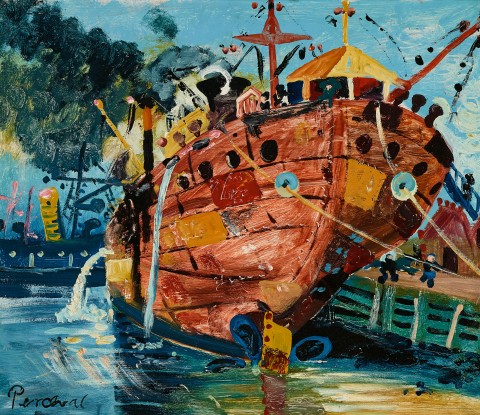THE HULL, WILLIAMSTOWN, 1956
JOHN PERCEVAL
oil on composition board
61.0 x 71.0 cm
signed lower left: Perceval
Barry Stern Gallery, Sydney
Kevin (Pro) Hart, Broken Hill, NSW, acquired from the above in 1968
Deutscher ~ Menzies, Sydney, 15 March 2006, lot 15
Gould collection, Melbourne
Deutscher and Hackett, Sydney, 15 March 2017, lot 5
Private collection, Melbourne
The Director’s Choice 2007, Gould Galleries, Melbourne, 17 February – 30 March 2007, cat. 7 (illus. in exhibition catalogue)
The Director’s Choice 2010, Gould Galleries, Melbourne, 16 May – 5 June 2010, cat. 5 (illus. in exhibition catalogue)
Allen, T., John Perceval, Melbourne University Press, Melbourne, 1992, p. 158 (as ‘Stern of a Cargo Ship, c.1956 – 59’)
John Perceval’s paintings of Williamstown from the 1950s are amongst the most sought after in Australian art and key examples now reside in the collections of the National Gallery of Victoria, National Gallery of Australia, Queensland Art Gallery, Bendigo Art Gallery, Newcastle Art Gallery and the Tarrawarra Museum of Art. Vibrant, swirling, blustery and above all superbly painted, the series depicts the working port as a source of fascinating contrasts. Although some harbour and dock drawings by the artist have been noted from as early as 1949, it was his purchase of a second-hand Volkswagen Beetle in the mid-1950s that transformed his ability to travel further distances from his family base in the eastern suburbs. With Charles Blackman, Arthur Boyd and Hal Hattam as occasional companions, Perceval explored Williamstown describing the experience as ‘like finding Venice.’1 This, of course, was the stuff of pure romance for the artist who had yet to travel overseas; nonetheless, it is an indication of his creative instinct that he could perceive such a poetic similarity amidst the working tugs, gulls, spilled fuel and battered hulks.
In The Hull, Williamstown, 1956 an aging vessel is moored at the docks, its stern a patchwork of metal plates of differing heritage and condition. Two wharf workers tug at the lines, smoke pollutes the air and bilge water spills out from near the Plimsoll line. It is a painting that almost begs to have a smell, one of salt, oil, soot and toil. Many contemporaneous critics mistakenly considered Perceval’s style to be one of a mindless joie de vivre, as if he were somehow untutored and the imagery contained no true technical skill or critical analysis. Considering his solid track record and well-known fascination with the art of Rembrandt and other masters, such shallow opinions were not appreciated by Perceval who commented in 1963 that ‘(s)ome critics have wrongly seen my work as action painting; but at all times my work is primarily a response to the subject, to light and trees, air, people etc. Whatever success it may achieve is due to the desire to equate the vitality, the pulse of life in nature and the world around us.’2 The Hull clearly demonstrates Perceval’s control with the brush as the pigment is almost alla prima, a situation where the purity of an original paint mark stays ‘true’ within the final work, that is, it is not over-painted at any time during the process. Further evidence is his compositional skill which includes visual cues – ropes, smoke, arcs of water and the spar extending from the stern – which all lead the eye around the scene.
In November 1956, Australian Galleries in Melbourne opened to great fanfare and their first exhibition featured John Perceval’s paintings of Williamstown and Gaffney’s Creek. Although painted at the same time, The Hull was not included in this inaugural showing as the artist and the gallery decided to keep to a uniform 3 x 4 foot size. When the artist and prominent collector Pro Hart owned it, he sent Perceval a Polaroid which inspired him to do a rare reinterpretation executed in his then-current style which favoured heightened colour. This new work (The Old Tug Boat, 1995) became the cover catalogue image for the celebrated exhibition John Perceval: Paintings 1990 – 1995 held at Gould Galleries in 1996.
1. Plant, M., John Perceval, Lansdowne Australian, Melbourne, 1971, p. 52
2 John Perceval, quoted in: Reed, J., New Painting 1952 – 1962, Longmans, Melbourne, 1963, p. 24
ANDREW GAYNOR
